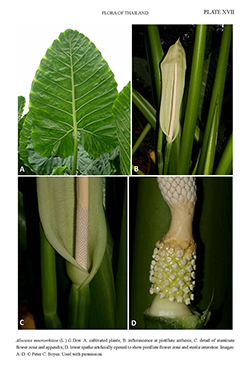e-Flora of Thailand
Volume 11 > Part 2 > Year 2012 > Page 126 > Araceae > Alocasia
7. Alocasia macrorrhizos (L.) G.Don
in R.Sweet, Hort. Brit., ed.3: 631. 1839; Schott, Syn. Aroid.: 45. 1856 (‘macrorrhiza’) & Prodr. Syst. Aroid.: 146–147. 1860 (‘macrorrhiza’); Engl. in A.DC. & C.DC., Monogr. Phan. 2: 502–503. 1879 (‘macrorrhiza’); Hook.f., Fl. Brit. India 6: 526. 1893 (‘macrorrhiza’); Ridl., Mat. Fl. Malay Penins.: 18 (sub. A. ovalifolia). 1907; Krause in Engl., Pflanzenr. IV, 23E (Heft 71): 84–85, fig. 15. 1920; Ridl., Fl. Malay Penins. 5: 99. 1925; Gagnep. in Lecomte, Fl. Indo-Chine 6: 1145. 1942; Hu, Dansk Bot. Ark. 23: 432. 1968; Hay, Gard. Bull. Singapore 50: 283. 1998; Boyce, Thai Forest Bull., Bot. 36: 13. 2008; Li & Boyce in H.Li et al., Fl. China 23: 77–78. 2010.— Arum macrorrhizos L., Sp. Pl. 965. 1753.— Colocasia macrorrhiza (L.) Schott in Schott & Endlicher, Melet. Bot. 1: 18. 1832. Plate XVII.
Accepted Name : This is currently accepted.
Synonyms & Citations :
Description : Massive, pachycaul, evergreen herb to 4 m with slightly milky latex. Stem erect to ca 1.5 m, then decumbent. Leaves several to rather many together, clustered at the tips of stems of larger plants; petioles to 1.3 m long, sheathing in lower ⅓–½, medium green, less often deep purple, or with moderately well-developed pale to medium brown reptilian markings;leaf blade ovate-sagittate, bluntly triangular in general outline, to 120 by 50 cm, held more or less erect, margin entire to very slightly sinuous, concolorous, bright green on both surfaces, less often green with deep purple veins, or the whole blade coppery-brown; primary lateral veins ca 9 on each side of the anterior costa; axillary glands of primary veins distinct; secondary venation flush with the blade or slightly raised abaxially, not forming interprimary collective veins or these only poorly defined; posterior lobes ca ⅓–½ the length of the anterior, somewhat rotund, often overlapping, naked in the sinus in adult plants, weakly peltate in juveniles. Inflorescences paired among the leaf bases, subtended by membranous cataphylls; peduncle barely exceeding the cataphylls at anthesis; spathe ca 13–35 cm long, constricted about ⅙ th of the way from the base; lower spathe green, ovoid; spathe limb broadly oblong-lanceolate, 10.5–29 cm long, hooded at anthesis, later reflexed, then deliquescent, membranous, pale yellow; spadix slightly shorter than the spathe, shortly stipitate; pistillate flower zone conical-cylindrical, 1–2 by ca 1.5 cm; ovaries pale green, ca 3 mm diam.; stigma sessile, 3–5-lobed, the lobes conical, yellow; sterile interstice slightly shorter than to equalling the pistillate zone, whitish, very slightly narrowed corresponding to the spathe constriction; synandrodia rhombo-hexagonal, ca 2.5 mm diam., lower ones paler, incompletely connate or with a central hole, the upper ones resembling synandria; staminate flower zone cylindrical, ca 3–7 by ca 2 cm, whitish; synandria 5–9-merous, rhombo-hexagonal, convex-topped owing to cap-forming synconnective, ca 2 mm diam.; appendix slightly thicker than the staminate zone at the base, then tapering, equalling to considerably exceeding half the length of the spadix, yellowish. Fruiting spathe oblong-ellipsoid, ca 8 cm long, green; fruits ellipsoid, ca 12 by 8 mm, ripening scarlet.
Thailand : PENINSULAR: Phuket. See note below.
Distribution : Indo-Malesia to Oceania. It is not clear where, if anywhere, this species occurs wild. It was evidently distributed widely in tropical Asia as a subsistence crop in prehistoric times and is now pantropical by introduction as an ornamental. For discussion of the very extensive synonomy see Hay, Wise, Blumea 35, 499–545. 1991, and Hay, Gard. Bull. Singapore 50(2): 221–334, 1998.
Ecology : Roadside ditches, margins of wet fields, frequently cultivated as an ornamental in a number of selected forms; 0–500 m alt.
Vernacular : Kradat (กระดาด)(Bangkok); khue (คือ), tho-pa (โทป๊ะ)(Karen-Mae Hong Son); bon kawi (บอนกาวี)(Yala); khueak kala (เผือกกะลา), man thopat (มันโทป้าด)(Mae Hong Son); phueak-tho-pat (เผือกโทป้าด)(Shan-Mae Hong Son); kradat dam (กระดาดดำ)(Kanchanaburi); kradat daeng (กระดาดแดง)(Bangkok); kla-di-bu-ko (กลาดีบูเก๊าะ)(Malay-Yala); buem bue (บึมบือ)(Chiang Mai); hora (โหรา)(Songkhla, Yala); o lai (เอาะลาย)(Yala).
Uses: Stems formerly used as a subsistence crop in times of famine.
Notes: Together with Alocasia cucullata, this is the commonest aroid in Thailand, yet there are almost no collections in herbaria, probably because, being so common and also difficult to voucher well, it is routinely ignored by fieldworkers.
Alocasia macrorrhizos is never encountered in the wild but is always closely associated with human settlement. Alocasia macrorrhizos and A. cucullata may both be cultigens. Ornamental varieties have been recognised and were discussed by Furtado (1941).
Alocasia macrorrhizos and A. hypoleuca may be readily confused, although A. macrorrhizos differs by the ultimately decumbent stem, leaf blades abaxially glossy green (not glaucous), the spathe limb not glaucous, the fewer, larger synandria with convex synconnectives, the longer spadix appendix and only weakly divided, spreading stigmas. In fruit the spathe limb of A. macrorrhizos is soon deliquescent (vs marcescent).

